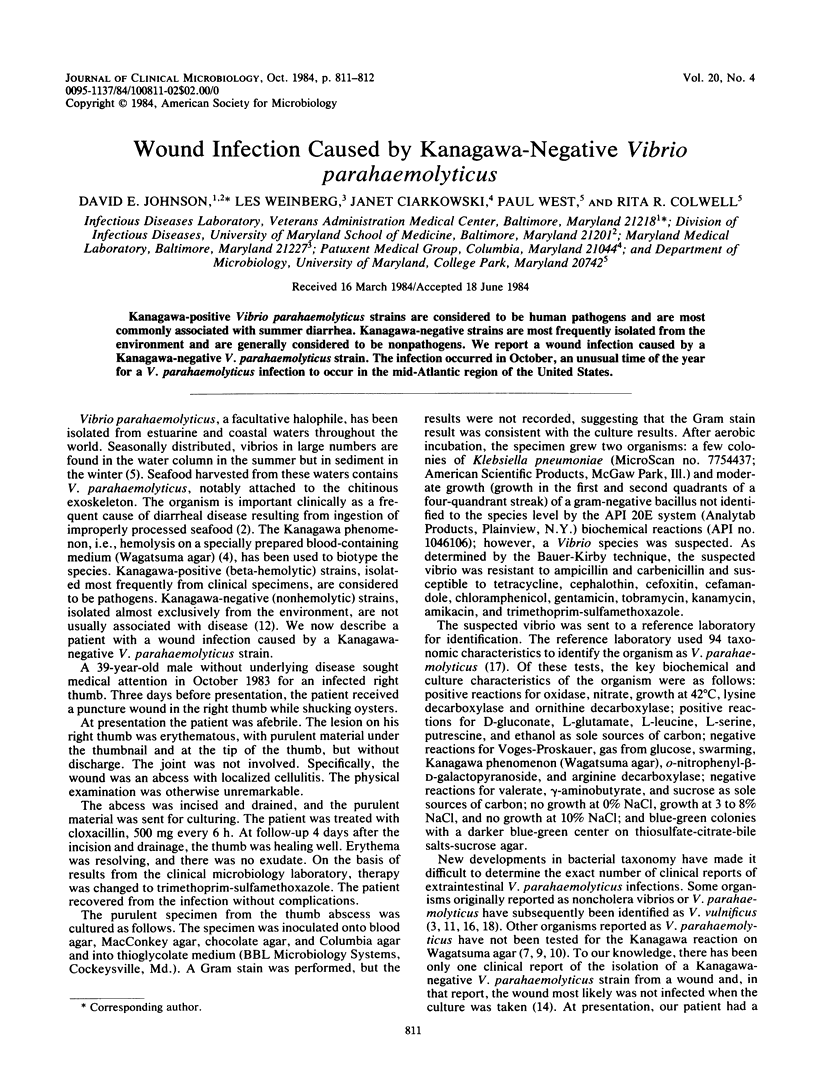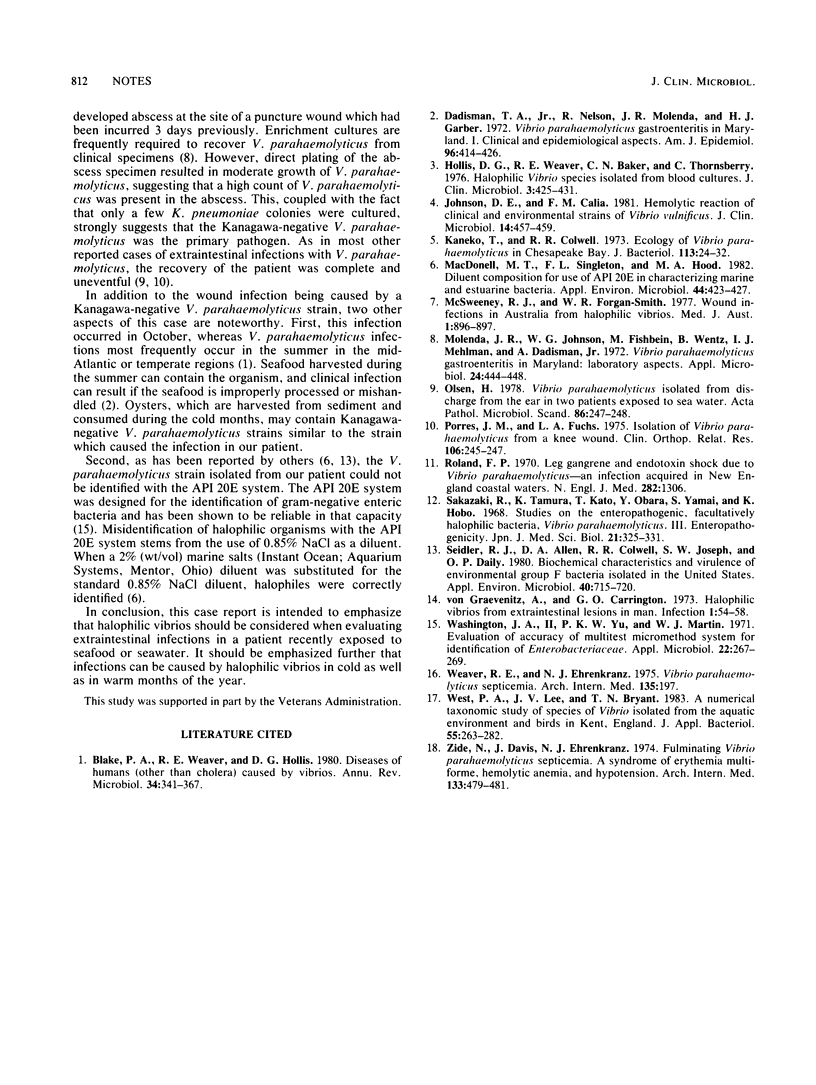Abstract
Kanagawa-positive Vibrio parahaemolyticus strains are considered to be human pathogens and are most commonly associated with summer diarrhea. Kanagawa-negative strains are most frequently isolated from the environment and are generally considered to be nonpathogens. We report a wound infection caused by a Kanagawa-negative V. parahaemolyticus strain. The infection occurred in October, an unusual time of the year for a V. parahaemolyticus infection to occur in the mid-Atlantic region of the United States.
Full text
PDF

Selected References
These references are in PubMed. This may not be the complete list of references from this article.
- Blake P. A., Weaver R. E., Hollis D. G. Diseases of humans (other than cholera) caused by vibrios. Annu Rev Microbiol. 1980;34:341–367. doi: 10.1146/annurev.mi.34.100180.002013. [DOI] [PubMed] [Google Scholar]
- Dadisman T. A., Jr, Nelson R., Molenda J. R., Garber H. J. Vibrio parahaemolyticus gastroenteritis in Maryland. I. Clinical and epidemiologic aspects. Am J Epidemiol. 1972 Dec;96(6):414–426. doi: 10.1093/oxfordjournals.aje.a121474. [DOI] [PubMed] [Google Scholar]
- Hollis D. G., Weaver R. E., Baker C. N., Thornsberry C. Halophilic Vibrio species isolated from blood cultures. J Clin Microbiol. 1976 Apr;3(4):425–431. doi: 10.1128/jcm.3.4.425-431.1976. [DOI] [PMC free article] [PubMed] [Google Scholar]
- Johnson D. E., Calia F. M. Hemolytic reaction of clinical and environmental strains of Vibrio vulnificus. J Clin Microbiol. 1981 Oct;14(4):457–459. doi: 10.1128/jcm.14.4.457-459.1981. [DOI] [PMC free article] [PubMed] [Google Scholar]
- Kaneko T., Colwell R. R. Ecology of Vibrio parahaemolyticus in Chesapeake Bay. J Bacteriol. 1973 Jan;113(1):24–32. doi: 10.1128/jb.113.1.24-32.1973. [DOI] [PMC free article] [PubMed] [Google Scholar]
- MacDonell M. T., Singleton F. L., Hood M. A. Diluent composition for use of API 20E in characterizing marine and estuarine bacteria. Appl Environ Microbiol. 1982 Aug;44(2):423–427. doi: 10.1128/aem.44.2.423-427.1982. [DOI] [PMC free article] [PubMed] [Google Scholar]
- McSweeney R. J., Forgan-Smith W. R. Wound infections in Australia from halophilic vibrios. Med J Aust. 1977 Jun 11;1(24):896–897. [PubMed] [Google Scholar]
- Molenda J. R., Johnson W. G., Fishbein M., Wentz B., Mehlman I. J., Dadisman T. A., Jr Vibrio parahaemolyticus gastroenteritis in Maryland: laboratory aspects. Appl Microbiol. 1972 Sep;24(3):444–448. doi: 10.1128/am.24.3.444-448.1972. [DOI] [PMC free article] [PubMed] [Google Scholar]
- Olsen H. Vibrio parahaemolyticus isolated from discharge from the ear in two patients exposed to sea water. Acta Pathol Microbiol Scand B. 1978 Aug;86(4):247–248. doi: 10.1111/j.1699-0463.1978.tb00038.x. [DOI] [PubMed] [Google Scholar]
- Porres J. M., Fuchs L. A. Isolation of Vibrio parahaemolyticus from a knee wound. Clin Orthop Relat Res. 1975 Jan-Feb;(106):245–247. doi: 10.1097/00003086-197501000-00036. [DOI] [PubMed] [Google Scholar]
- Roland F. P. Leg gangrene and endotoxin shock due to vibrio parahaemolyticus--an infection acquired in New England coastal waters. N Engl J Med. 1970 Jun 4;282(23):1306–1306. doi: 10.1056/NEJM197006042822306. [DOI] [PubMed] [Google Scholar]
- Sakazaki R., Tamura K., Kato T., Obara Y., Yamai S. Studies on the enteropathogenic, facultatively halophilic bacterium, Vibrio parahaemolyticus. 3. Enteropathogenicity. Jpn J Med Sci Biol. 1968 Oct;21(5):325–331. doi: 10.7883/yoken1952.21.325. [DOI] [PubMed] [Google Scholar]
- Seidler R. J., Allen D. A., Colwell R. R., Joseph S. W., Daily O. P. Biochemical characteristics and virulence of environmental group F bacteria isolated in the United States. Appl Environ Microbiol. 1980 Oct;40(4):715–720. doi: 10.1128/aem.40.4.715-720.1980. [DOI] [PMC free article] [PubMed] [Google Scholar]
- Washington J. A., 2nd, Yu P. K., Martin W. J. Evaluation of accuracy of multitest micromethod system for identification of Enterobacteriaceae. Appl Microbiol. 1971 Sep;22(3):267–269. doi: 10.1128/am.22.3.267-269.1971. [DOI] [PMC free article] [PubMed] [Google Scholar]
- Weaver R. E., Ehrenkranz N. J. Letter: Vibrio parahaemolyticus septicemia. Arch Intern Med. 1975 Jan;135(1):197–197. doi: 10.1001/archinte.135.1.197. [DOI] [PubMed] [Google Scholar]
- West P. A., Lee J. V., Bryant T. N. A numerical taxonomic study of species of Vibrio isolated from the aquatic environment and birds in Kent, England. J Appl Bacteriol. 1983 Oct;55(2):263–282. doi: 10.1111/j.1365-2672.1983.tb01324.x. [DOI] [PubMed] [Google Scholar]
- Zide N., Davis J., Ehrenkranz N. J. Fulminating vibrio parahemolyticus septicemia. A syndrome of erythemia multiforme, hemolytic anemia, and hypotension. Arch Intern Med. 1974 Mar;133(3):479–481. doi: 10.1001/archinte.133.3.479. [DOI] [PubMed] [Google Scholar]
- von Graevenitz A., Carrington G. O. Halophilic vibrios from extraintestinal lesions in man. Infection. 1973;1(1):54–58. doi: 10.1007/BF01638258. [DOI] [PubMed] [Google Scholar]


